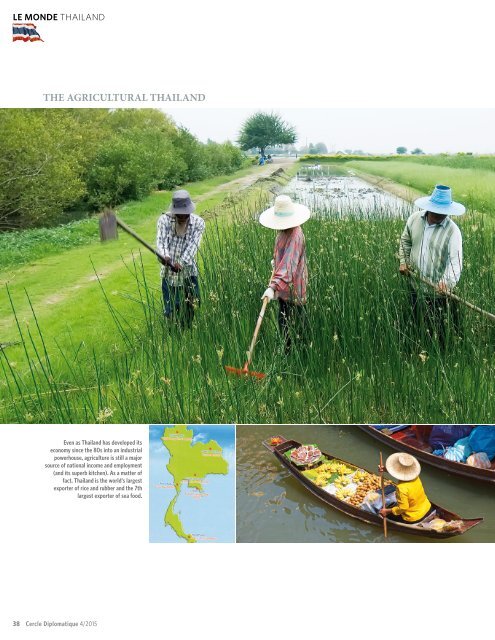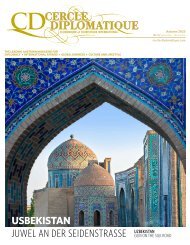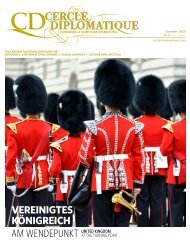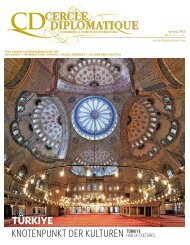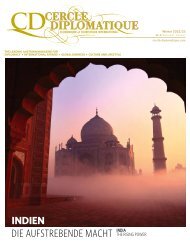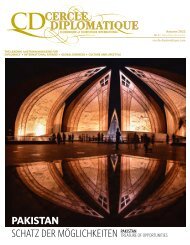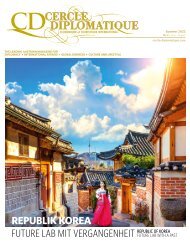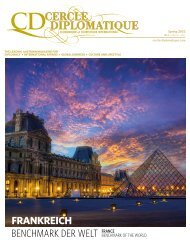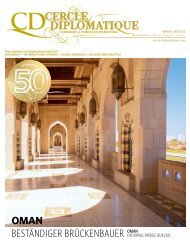CERCLE DIPLOMATIQUE - issue 04/2015
CD is an independent and impartial magazine and is the medium of communication between foreign representatives of international and UN-organisations based in Vienna and the Austrian political classes, business, culture and tourism. CD features up-to-date information about and for the diplomatic corps, international organisations, society, politics, business, tourism, fashion and culture. Furthermore CD introduces the new ambassadors in Austria and informs about designations, awards and top-events. Interviews with leading personalities, country reports from all over the world and the presentation of Austria as a host country complement the wide range oft he magazine.
CD is an independent and impartial magazine and is the medium of communication between foreign representatives of international and UN-organisations based in Vienna and the Austrian political classes, business, culture and tourism. CD features up-to-date information about and for the diplomatic corps, international organisations, society, politics, business, tourism, fashion and culture. Furthermore CD introduces the new ambassadors in Austria and informs about designations, awards and top-events. Interviews with leading personalities, country reports from all over the world and the presentation of Austria as a host country complement the wide range oft he magazine.
Create successful ePaper yourself
Turn your PDF publications into a flip-book with our unique Google optimized e-Paper software.
LE MONDE THAILAND<br />
THE AGRICULTURAL THAILAND<br />
Even as Thailand has developed its<br />
economy since the 80s into an industrial<br />
powerhouse, agriculture is still a major<br />
source of national income and employment<br />
(and its superb kitchen). As a matter of<br />
fact, Thailand is the world‘s largest<br />
exporter of rice and rubber and the 7th<br />
largest exporter of sea food.<br />
PHOTOS: PETER LECHNER<br />
PHOTOS: TOURISM AUTHORITY OF THAILAND, FOTOLIA (3)<br />
trians each year. As a result, the tourism industry<br />
contributes around 15 percent to Thailand’s GDP,<br />
which last year was around 373 billion US-dollars<br />
(nominal) or some 5.420 dollars per capita.<br />
So once a farang puts foot on the soil of Siam, the<br />
name by which the country was known to the world<br />
until 1939 and again between 1945 and 1949, there is<br />
no way not to be charmed by the seven gems. First, of<br />
course, there is Thai food, known for its fiery rich<br />
flavour combinations, unique cooking styles and<br />
age-old methods of preserving foods and offering<br />
nutrition. Thai food, such as best loved dishes like<br />
Phat Thai, Tom Yam Gung, and the fiery Som Tam<br />
salad, can be enjoyed at local street stalls, filled with<br />
scents and atmosphere.<br />
Which directly leads to gem Nr. 2 – the Thai way<br />
of life. Thai people’s hospitable personality is what<br />
contributes to the unique and distant feature of a local<br />
community, which is shaped by its members’ livelihood,<br />
house building and designing techniques,<br />
production of household and farming articles, and<br />
adherence to a religion and beliefs inherited by their<br />
ancestors. ”When it comes to religion, Thailand is<br />
fundamentally liberal“, says Gresser. A feature seems<br />
to be essentially a result of the third gem – Thai wisdom.<br />
As Buddhism is embraced by more than 90<br />
percent of Thai (some five percent are Muslims, a few<br />
are Hindu and Christians) the country and its people<br />
are like a storehouse of knowledge and wisdom, given<br />
the country’s long history of religion, philosophy,<br />
folk wisdom and traditions of oral teaching<br />
passed down in families and in the temples.<br />
At this point, it is interesting to remark that there<br />
are conflicting opinions as to the origins of the Thais.<br />
Three decades ago, it could be said with presumed<br />
certainty that the Thais originated in Northwestern<br />
Szechuan in China about 4.500 years ago and later<br />
migrated down to their present homeland. However,<br />
this theory was altered by the discovery of remarkable<br />
prehistoric artifacts in the village of Ban Chiang in<br />
the Nong Han District of Udon Thani Province in<br />
the Northeast. These include evidence of bronze metallurgy<br />
going back 3.500 years, as well as other indications<br />
of a far more sophisticated culture than any<br />
previously suspected by archaeologists. It now appears<br />
that the Thais might have originated in Thai<br />
territory and later scattered to various parts of Asia,<br />
including some parts of China.<br />
Maybe the fourth gem – Thai arts – represents the<br />
best expression of modern Thailand, which was pro-<br />
King Bhumibol<br />
Adulyadej, better<br />
known as Rama IX,<br />
the 9th monarch of<br />
the Chakri Dynasty.<br />
38 Cercle Diplomatique 4/<strong>2015</strong>


